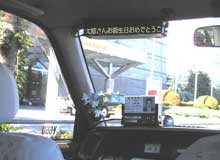 This taxi features a news ticker that also displays personal messages from clients. (Keystone) |
|
CAB COMFORT:
Competition Intensifying in the Taxi Business
October 15, 2002
Taxi services in Japan are rapidly diversifying.
Prior to February 2002, nearly every taxi company primarily used medium-sized
cars of the 1,500-cc class, charged ¥660 for the first two kilometers,
and provided more or less uniform services. With the enforcement on February
1 of the revised Road Transport Law, however, regulations on market entry
and fares have been drastically eased. Competition has been heating up
as taxi companies race to gain the favor of passengers with innovative
services.
That Rich Feeling
Some start-ups have elected for luxury foreign cars, drawing the eyes
of passersby. American Taxi, a Tokyo company launched in September 2002,
uses - despite its name - the British Jaguar S-Type. With an initial fleet
of 10 of these cars, it hopes to enlist company executives and others
as regular customers. Tokyo's Fukuneko Taxi, which also began operating
in September, uses 5 Mercedes-Benz C 180 sedans. It has adopted the strategy
of entering into contracts with posh restaurants in order to obtain affluent
customers looking to catch a ride home after dining out. Maihama Resort
Cab of Chiba Prefecture, meanwhile, has a tie-up with Tokyo Disneyland.
It has introduced 10 Chrysler PT Cruisers and aims to lure customers who
want to hold on to that lingering Disney feeling all the way home.
Reportedly, using luxury cars as taxis has the added benefit of improved
driver attitudes, as sitting behind the wheels of such cars give drivers
a boost of self-esteem.
Falling Prices
Fares are another focus of competition. In Osaka, a center of a fierce battle for passengers,
there are said to be about 3,500 taxis in excess of demand. Several taxi
companies in the area have lowered or are planning to lower their base
fares from the standard ¥660 ($5.50 at ¥120 to the dollar) to
¥600, ¥550, and even ¥500 - touted as a "one coin"
fare because all it takes in the first two kilometers is a single ¥500
coin. Moreover, a growing number of companies are giving long-distance
customers a 50% discount for the portion of the fare that exceeds ¥5,000.
This trend toward lower fares is spreading nationwide, and Hinomaru Transportation
Co., an established taxi company in Tokyo, has decided to slash its base
fare to ¥250, albeit for a reduced distance of 700 meters instead
of the usual 1 km.
Taxis in Japan have long been known for their high rates compared to those
of other countries. According to a survey that Japan's Ministry of Land,
Infrastructure, and Transport carried out in October 2000, the average
fares of major cities in other countries, with
100 as Tokyo's average, were (for a 5-km daytime ride, calculated with
the average exchange rates for October 2000): 53 for New York, 67 for
London, 58 for Frankfurt, and 32 for Paris. But now customers can expect
to see lower fares in Japan, too, thanks to deregulation and the resultant
increase in competition.
More Services
Taxi operators are also enticing customers with unique services. Kanagawa-based
Kanachu Hire Corp. promotes use of a smart card with the catchphrase,
"Reach home while you sleep." Customers can have up to three
destinations input in their card, which they hand to the driver when they
board the taxi. By scanning the card on a car navigation system, the driver
can transport them all the way home even if they fall asleep drunk. The
company intends to recommend the smart card to clients such as people with hearing impairments
and the elderly.
Then there are some companies whose drivers stand by the passenger door
to open and close it for the customer, much like a limousine.
Japanese taxis have "automatic" back seat doors that drivers
open and close with a lever, but these companies aspire to provide more
personal, sincere services. Meanwhile, some are training their drivers
in basic English conversation so that they can talk with foreign passengers
and explain the situation when they are caught in traffic. Their aim,
of course, is to gain clients who work for foreign-owned firms.
Other unusual services include extra perks like free in-car use of mini-TVs,
massage machines, electrical outlets, or wet towels, doing errands for
the customer (such as picking up prescription drugs or food), pet taxis,
and a messaging service using the small news tickers fitted on many cabs.
Taxis are growing into more than just a means of transportation.
|
Copyright (c) 2002 Japan
Information Network. Edited by Japan Echo Inc. based on domestic Japanese
news sources. Articles presented here are offered for reference purposes
and do not necessarily represent the policy or views of the Japanese
Government. |



